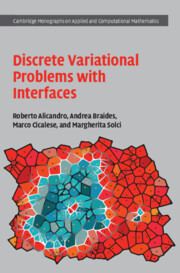
-
Select format
-
- Publisher:
- Cambridge University Press
- Publication date:
- January 2024
- December 2023
- ISBN:
- 9781009298766
- 9781009298780
- Dimensions:
- (229 x 152 mm)
- Weight & Pages:
- 0.533kg, 295 Pages
- Dimensions:
- Weight & Pages:
You may already have access via personal or institutional login
Book description
Many materials can be modeled either as discrete systems or as continua, depending on the scale. At intermediate scales it is necessary to understand the transition from discrete to continuous models and variational methods have proved successful in this task, especially for systems, both stochastic and deterministic, that depend on lattice energies. This is the first systematic and unified presentation of research in the area over the last 20 years. The authors begin with a very general and flexible compactness and representation result, complemented by a thorough exploration of problems for ferromagnetic energies with applications ranging from optimal design to quasicrystals and percolation. This leads to a treatment of frustrated systems, and infinite-dimensional systems with diffuse interfaces. Each topic is presented with examples, proofs and applications. Written by leading experts, it is suitable as a graduate course text as well as being an invaluable reference for researchers.
Contents
Metrics
Altmetric attention score
Full text views
Full text views help Loading metrics...
Loading metrics...
* Views captured on Cambridge Core between #date#. This data will be updated every 24 hours.
Usage data cannot currently be displayed.
Accessibility standard: Unknown
Why this information is here
This section outlines the accessibility features of this content - including support for screen readers, full keyboard navigation and high-contrast display options. This may not be relevant for you.
Accessibility Information
Accessibility compliance for the PDF of this book is currently unknown and may be updated in the future.


